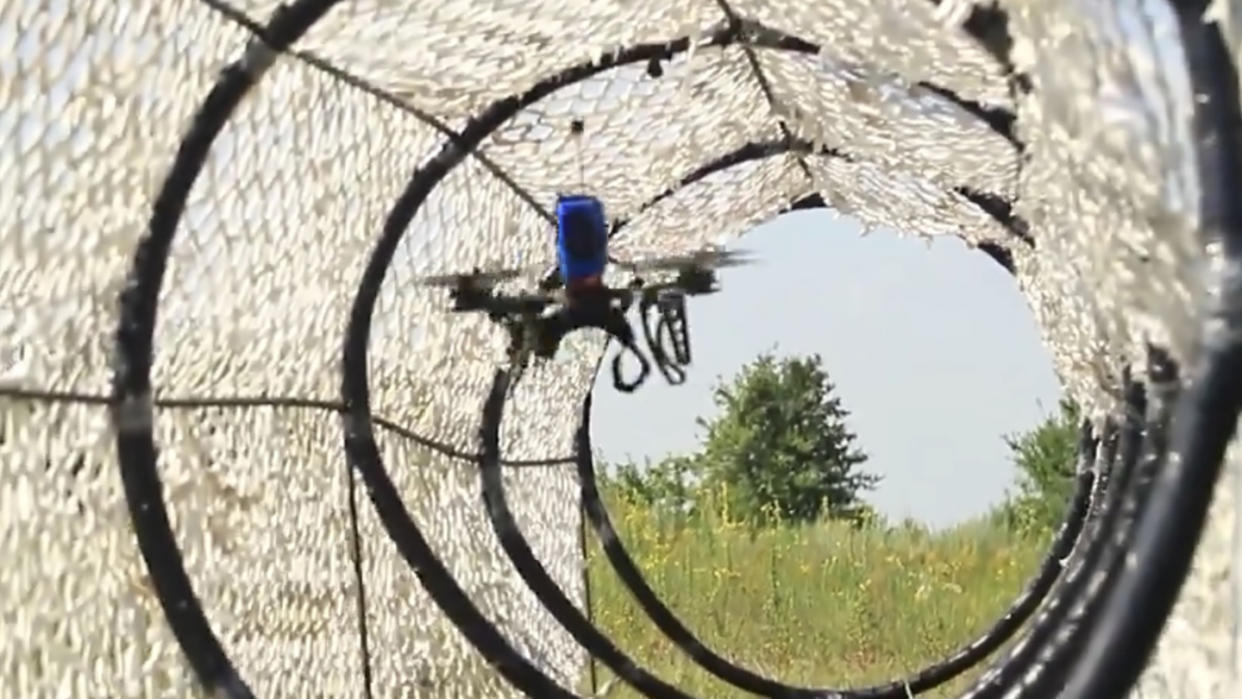Ukraine’s FPV Drone Obstacle Course Teaches How To Chase Vehicles, Fly Into Windows

The Ukrainian cope cage-covered Nissan SUV rumbled down a dirt road, chased by a First-Person View (FPV) drone zipping through the sky with an angry buzz. At first glance, this seemed like a video seen many times on social media. Both sides use these light, fast, highly maneuverable flying munitions as fearsome attack weapons.
The driver, however, was in no danger. He was motoring through a training ground’s obstacle course designed to help teach new Ukrainian FPV pilots how to fly over, around, and through objects, avoid electronic warfare countermeasures, and hit moving targets.
Obstacle course training for Ukrainian FPV & bomber drone operators.
Operators work with caged civilian cars & under EW. pic.twitter.com/riAJiCT5c4— Clash Report (@clashreport) July 11, 2024
It’s one thing to have drones. It is something else altogether to reliably guide them to dynamic targets across a chaotic and bloody battlefield. While the many videos of attacks on tanks, trucks, and troops like the one below make it look easy, it’s not.
One FPV drone, one russian IFV, one epic destruction.
: Azov Brigade pic.twitter.com/ZRGqLFxwJF
— Defense of Ukraine (@DefenceU) July 12, 2024
“We have a constant need to train our pilots and operators. The world of unmanned systems is constantly changing and the enemy comes up with certain methods or can prevent us from completing our tasks,” said one of the soldiers, who goes by callsign Teenager. “We have the opportunity to constantly train and improve our skills.”
As he speaks, the video cuts to an FPV drone flying through a net-covered tube obstacle. It’s one of the many hurdles new pilots have to navigate as they become familiar with flying and experienced pilots have to use to refresh their skills.
For rookies, just getting to that stage takes time.
“Our training is done in several stages,” said another soldier, callsign Glory. “It starts with a base of basic summer practices, then the second stage is more complex practices, and then there are application tactics, where our pilots learn to counter the enemy, an imitation of what is on the battlefield.”
The obstacle course offers many challenges, from mockups of building facades to slaloming around metal poles to buzzing through hoops. There are also static targets, like an old automobile.

“There are training grounds for practicing motor skills, there are targets that can always be hit, there are…tools so that pilots can prepare and learn to work not just in hothouse conditions, but in conditions as close as possible to combat,” Teenager explained.
This training teaches pilots to make kills that look right out of a dystopian movie, including strikes through open windows, doors and tank hatches.
The program is about more than just learning how to fly and fight. Successful FPV operations require munitions mated to the drone and a constant need for parts. Among other skills, the new operators learn to use a FlyingBear high-speed 3-D printer to fashion needed pieces.

As FPV drones have become a weapon of choice in this war, the demand for people to fly them is intense and about to become more so.
The Ukraine Defense Contact Group’s Drone Coalition signed a memorandum of understanding on Wednesday at the NATO Summit pledging to provide one million FPV drones to Ukraine. So far, the Netherlands, United Kingdom, Latvia, New Zealand, and Sweden have promised $49 million to rapidly procure them. More funds are expected as well.
Latvia is providing a drone testing training range for industry and the military to continuously improve drone technology. The U.K. has launched an industry competition on behalf of the Drone Coalition to develop and procure FPV drones. To date, that effort has received 265 bids, which are currently being evaluated. The first contracts are expected to be signed in August.
The coalition, however, will give Ukraine more than just FPV drones.
“At the same time, coalition members are working to provide other types of drones like reconnaissance, strike drones, AI-upgraded drones, as well as counter-drone capabilities. Through the Drone Coalition, we will be seeking joint procurement initiatives to utilize and expand national industrial capacities.”

Thanks to a major recruiting effort by the Ukrainian Ground Forces Command, there is a steady stream of people interested in flying FPV drones to kill Russian fighters.
They come from the military as well as the civilian world, said Teenager.
Gamers make up a good portion of that cadre.
“Maybe if yesterday you were grieving for Mom, today you are a great find for the Army and a great danger for the enemy,” he said.
Contact the author: [email protected]

